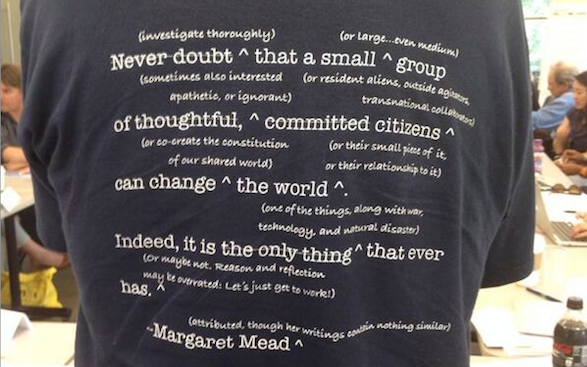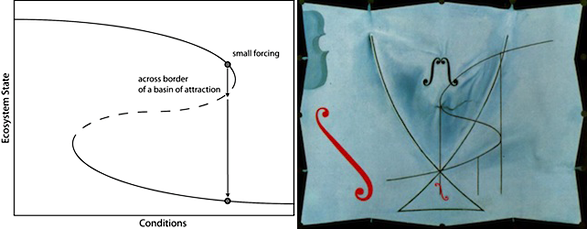 In my experience, the famous Margaret Mead quote elicits widely divergent reactions.
In my experience, the famous Margaret Mead quote elicits widely divergent reactions.
Never doubt that a small group of thoughtful, committed citizens can change the world. Indeed, it is the only thing that ever has.
Some find it inspiring, but I’m pretty skeptical. So I was delighted to see the photo at top, in which the quote is hilariously dissected on a t-shirt. (From a tweet by Dave Witzel, reprinted with permission.)
At the same time, the claim by the t-shirt’s creator that Mead’s “writings contain nothing similar” caught my attention. To be sure, the attribution is disputed. Still, Mead did write about these topics. How similar is similar? You be the judge.
Glancing through Mead’s 1964 Continuities in Cultural Evolution, the primary theme is indeed the significance of the “small group” in the processes of cultural change. To get a sense of what the book is about, I’ll suggest a comparison. Think of it as a 60s version of Steven Johnson’s Where Good Ideas Come From.
Like Johnson, Mead’s sensibility is evolutionary. She’s writing about how cultures evolve, not about how activists might intervene to “change the world.” In a word — today’s omnipresent buzzword — both Mead and Johnson are in search of innovation. They wonder and examine what types of cultural contexts afford the rapid emergence of social innovations.
Mead:
If we are indeed to participate in evolution not merely by creating new technology, new medical techniques, new kinds of foods, and new forms of communication, but more specifically by participating in the very process of cultural creation, what hope does our accumulated experience of the last thirty years give us?
Today, our experiences have accumulated further. Johnson can draw from post-Mead research on complexity theory (e.g., the adjacent possible) and network theory (e.g., strong and weak ties).
Still, Mead and Johnson come to strikingly similar conclusions. Examples of good environments for incubating good ideas, according to Johnson: the lab meetings where researchers exchange information (e.g., in Kevin Dunbar’s research), Freud’s salons, Paris cafés.
Mead’s version:
I find myself returning to the model of the city or the great university and to the model of the meeting place to which certain people go often enough so they may hope to meet one another but not so often that the element of surprise and excitement is lacking. In the modern American setting, seminars and small shared projects (provided these do not become a new set of confining walls within which development is subordinated to the timely completion of the project) replace the cafés and coffee houses that we have never been able to reproduce.
Fifty years later, the city is widely celebrated, America finally has coffee houses, and designing for creative interactions has become an industry in itself. I wonder what she’d think.
Here’s the key quote from Mead, the one about the small groups that she called “evolutionary clusters,” the one that’s probably closest to the bumper-sticker quote:
The unit of cultural micro-evolution is a cluster of interacting individuals who within the special conditions provided by period and culture make choices which set a direction — a channel — in which events tend to flow until other points of divergence are reached.
Similar? I love the t-shirt regardless of the similarities I see.
Does the concept of clusters place greater emphasis on strong ties than Johnson did? Seems that way to me. Certainly, network theory highlights “the strength of weak ties.”
As for Mead’s personal clusters, two are about to gather again. Today begins the 58th meeting of the International Society for System Sciences, next week is the 50th anniversary of the American Society for Cybernetics. Not changing the world, that’s for sure. “Making choices [that] set a direction” is ambitious enough for any group of thoughtful, committed citizens.
There’s more about the quote at the website of the defunct Institute for Intercultural Studies, which Mead founded, and more about evolutionary clusters in Steve Joshua Heims’s The Cybernetics Group, which tells a story of the Macy Conferences, where Mead was a key participant.
 The practice of resilience assessment requires some key conceptual framings.
The practice of resilience assessment requires some key conceptual framings.
 Portland-based artist
Portland-based artist  In my experience, the famous Margaret Mead quote elicits widely divergent reactions.
In my experience, the famous Margaret Mead quote elicits widely divergent reactions.
